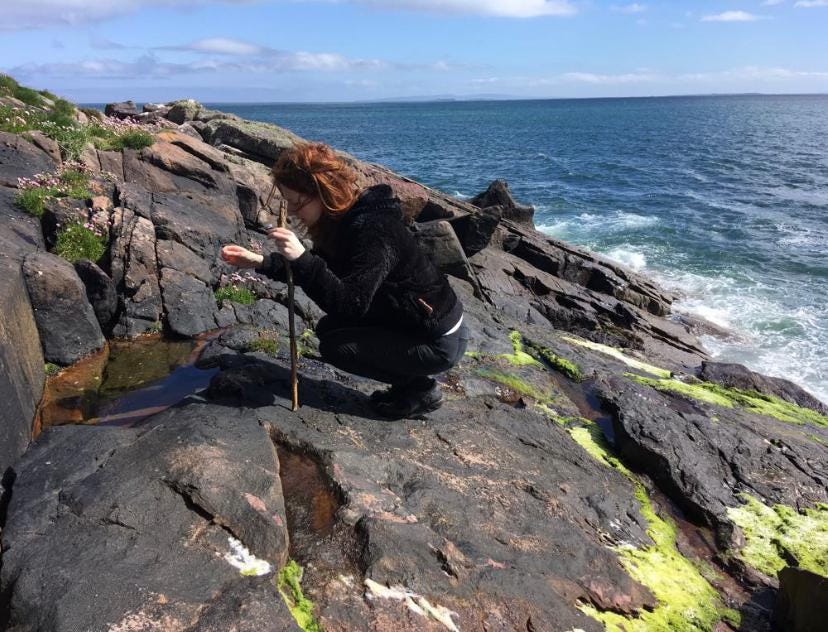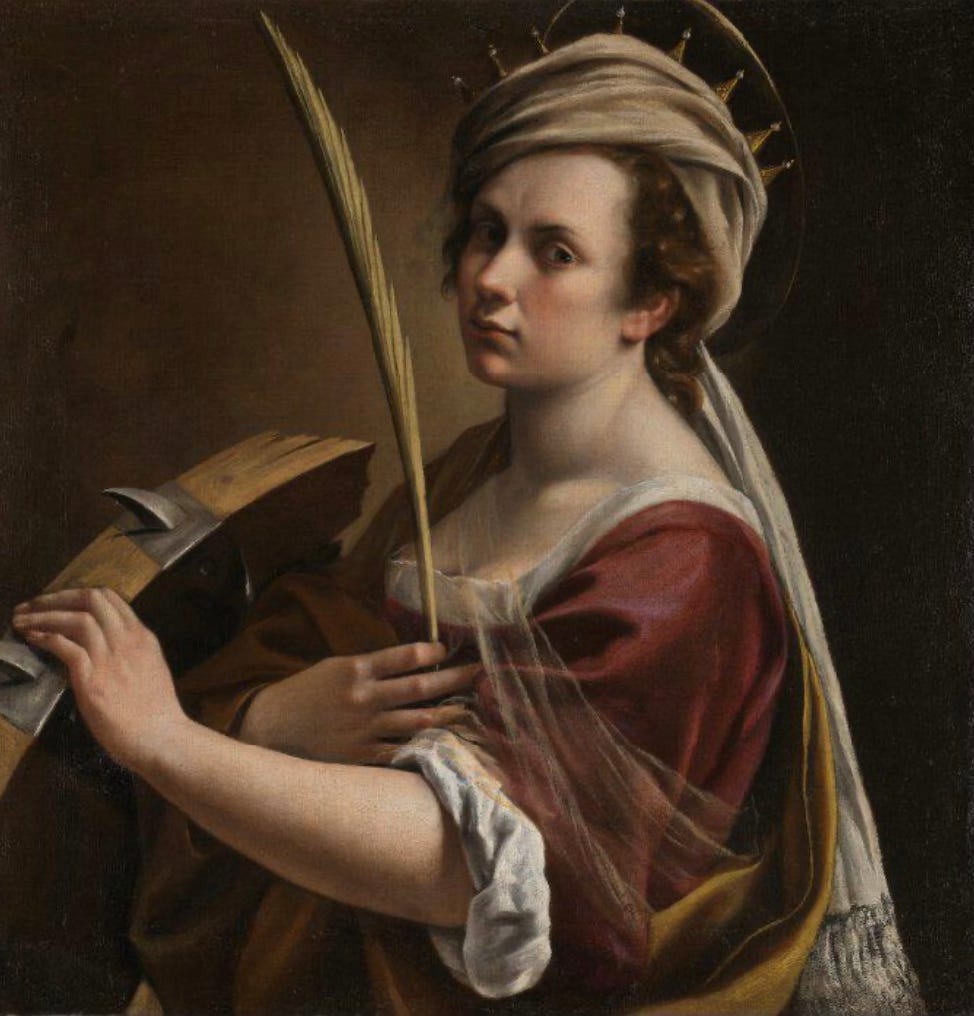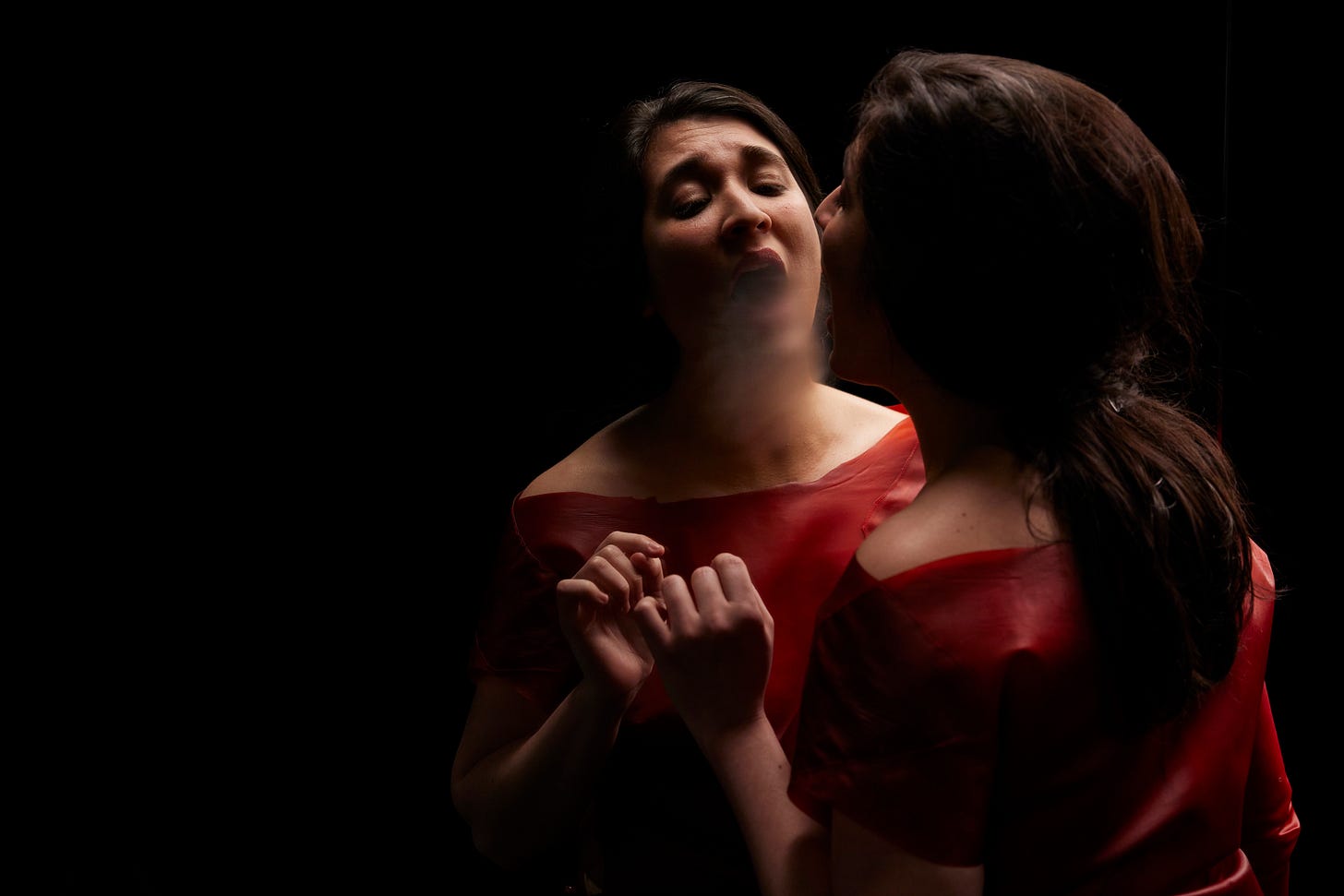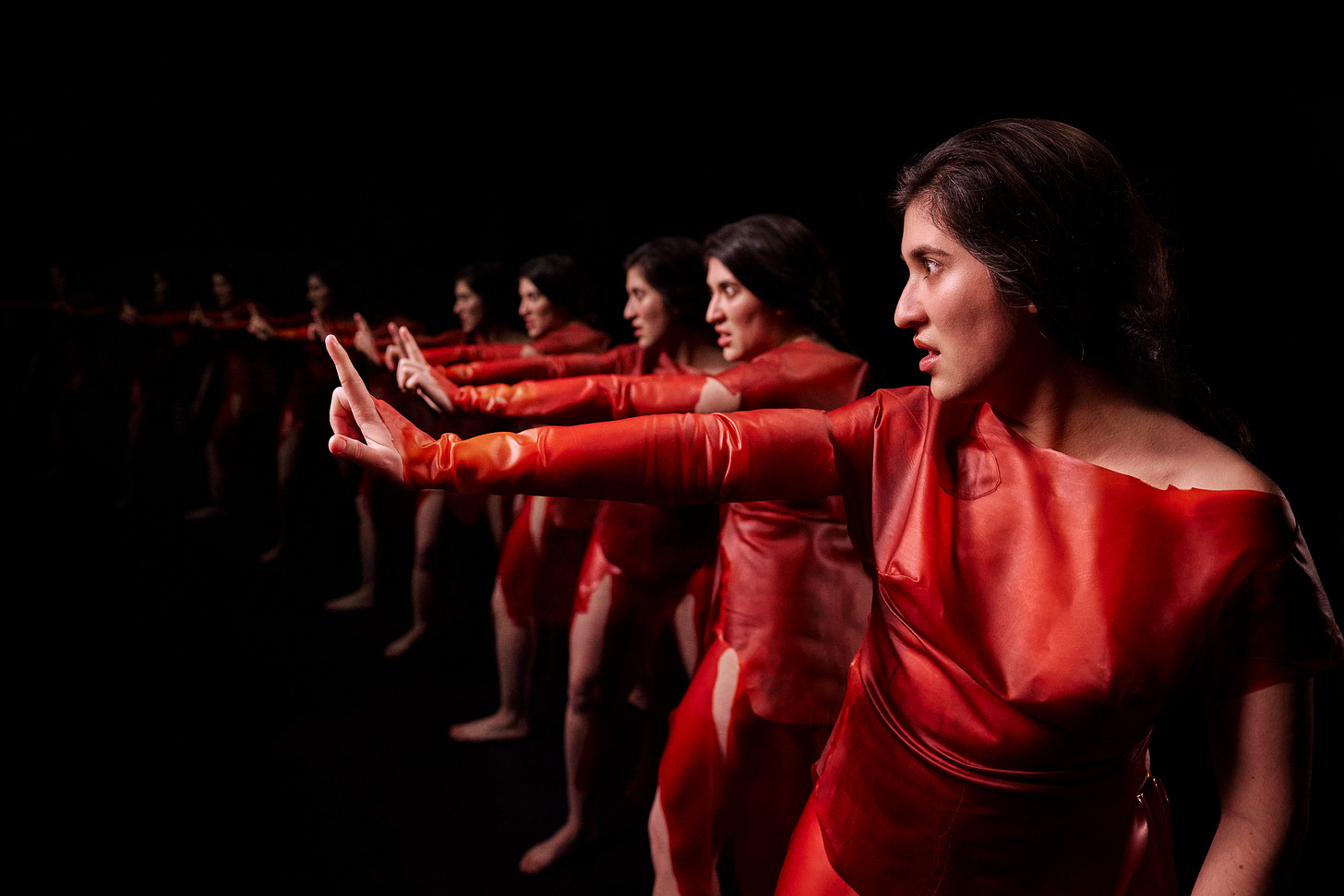Mirror Martyr Mirror Moon
I sat down with the inimitable Jesse Jones before the opening of her show Mirror Martyr Mirror Moon. The following text is a transcript detailing the empathetic, intuitive, origins of this timely and beautifully-crafted show that illuminates Jesse’s singular approach to making art.
‘Mirror Martyr Mirror Moon is a 16mm film made in response to a painting by Artemisia Gentileschi called Self Portrait as Saint Catherine of Alexandria, made in 1616. When I was asked by the National Gallery and IKON Gallery to make a work for the bicentenary of the National Gallery that would be shown alongside the original Gentileschi painting, I saw this as a collaboration from the beginning with Gentileschi.
In a lot of ways the research I was making, reading books about Gentileschi, researching her life, her story and how she came to see herself, creating Self Portrait as Saint Catherine was pretty significant. From the very beginning I tried to think of Gentileschi not as a painter but as somebody who is a proto-performance artist or proto-cinematic visionary.
The most significant thing about the painting for me - was the naming of the painting ‘Self Portrait as Saint Catherine’ - the word “as” was the most significant hinge that the whole painting stood on, and thinking about that affinity or that sense of identification that we make through art and the act of a self-portrait as an act of understanding the self, seeing ourselves within a storytelling.
A transgenerational affinity, that has always been significant to me, the idea of the art world or art history in particular as being a transgenerational affinity between artists. I think only artists can totally understand that because the act of making art is almost like a seance. You are aligning yourself with other moments of time. I don’t see such a liner separation of time when I am making an artwork. Its that crumpling of time between one moment and another. So by accident so many things happen when you crumple time.
One of the accidents that happened was the film, I never intended it to be 16 minutes long. I realised that once I was working in 16mm there was a materiality that connected the surface of the painting and the surface of the film. The film in the end, by absolute accident of performance that was compelling and what wasn’t compelling, became 16 minutes long. The joke I felt was played on me or with me was that the film was 1616 and the original Gentileschi painting was painted in 1616 so there is this symmetrical numerical quality between the film and the painting.
The painting itself is of Saint Catherine and Gentileschi paints it in a moment where she has left Rome after a very traumatic public moment where there was a rape trial between herself and the painter Agostino Tassi. It is one of the first documented public rape trails where we have testimonials of the victim and the perpetrator, what happened in court, and we also have evidence that Gentileschi was tortured during her testimony using thumb screws - that sense of torturing a woman who is on the brink of her career by holding her hands in these vices means we know we almost didn’t have Gentileschi, we almost didn’t have this masterful painter because of this particular torture sequence.
I feel that 4/5 years later when Gentileschi makes this painting ‘Self Portrait as Saint Catherine’ she presents herself as Saint Catherine to the viewer where her thumbs are tucked in behind her hands and uncannily she has no thumbs. In the painting her hands are held out to the audience but her thumbs are not visible, they are deliberately tucked away. So we see this sense of an artist using the self-portrait to make a political statement.
For me this painting is the inception of political feminist art where the image carries storytelling and a meaning of the collective oppression of women and I believe that this is very consciously made by Gentileschi in a defiant way. For me the painting is so powerful in terms off what is essential in the idea that feminist art didn’t just happen from the 1960’s onwards but that feminist art had its percolations for centuries if not from the beginnings of art that there were feminist possibilities the whole time.
Many of the breakthrough moments I have are through drawing. The breakthrough with the Gentileschi painting happened when I was staring at it and staring at it, and just made a little sketch where I folded the painting on top of itself and I realised when she is looking at us in the painting she is actually looking at herself because that is how you would make a painting like that as a self-portrait. You would be looking in the mirror, the canvas would be to the right or to the left.
And that realisation that she is actually engaged in a process of deep self-looking kicked off the idea around mirrors in relationship to the film and the idea of the mirror sculpture that the performer Stephanie Lamprea is trapped in, but by the end that sense of the multiple selves becomes a space of emancipation or joy. There is an arc to the film around the self that was very instinctual for me.
The story of the film is based on three characters Hypatia of Alexandria, Saint Catherine of Alexandria, who was actually Hypatia. They arrive at the same time but in terms of historical figures Hypatia of Alexandria is a documented figure from the 4th Century AD and she is probably more than likely the origin story Saint Catherine evolves from. Hypatia of Alexandria was a pagan, a mathematician and astronomer, who was publicly executed by a Christian mob for disagreeing with the dates that the emerging Gregorian calendar associated with Easter. She had her own theories that were based on astronomy and neoplatonic science and ideas. She was publicly executed using oyster shells to tear her body piece by piece. I was very compelled by the violence and the horror of that. Hypatia is considered one of the first public executions of a woman that was documented and recorded.
So that becomes an important part of the film, the moment at which Hypatia is torn to pieces, becomes this very strange section in the film that testimony looses its ability to be cognoscente and the performer Stephanie Lamprea really plays with that line of testimony of Hypatia’s death, and propels it as though it is a video tape through her body until it looses meaning. I think as a feminist one of the most difficult things we have to deal with is the veracity of our personal testimonies, when we speak we are not always believed or there is a certain level of epistemic injustice that happens with the female voice and its been around for centuries and centuries and centuries.
The film was made with sound first, before images. There were two parallel processes; I had been working with Emma Dalesman, the DOP and had described the visual world I was trying to create. In another parallel process with Irene Buckley and Stephanie Lamprea I was developing the score. The score was what I described as a cartographic score, the starting point in our devising was the mountain range of Mount Sinai in Egypt, which is the site where Saint Catherine’s body was mystically elevated after her martyrdom.
I was fascinated by this idea of how a mountain scape could become a sound score. We used this as the structure, and used some of the images from the storytelling such as the shape of oyster shells, the gravel on the path of the pilgrims journey to Sinai. So much of the research became the textures for the more abstracted elements of the work.
I had been developing text based on the work of Christine de Pizan, a French writer and feminist, who wrote a beautiful book called ‘The City of Ladies’. I had developed extracts from that and I was interested in who were the contemporaries of Gentileschi. One of her most brilliant contemporaries was a woman called Francesca Caccini, who was the same age as Gentileschi. When Gentileschi left Rome and went to live in Florence and then Venice, she became part of a baroque milieu which saw the birth of the contemporary Italian Opera. Francesca Caccini was one of the leaders of this movement and we wanted to include a piece of music by Francesca Caccini. Stephanie brought in a piece - ‘Lasciatemi Qui Solo”, a beautiful piece of music that tells this really intimate story that feels very connected to Gentileschi’s life.
So by bringing in contemporary voices we were able to tell Gentileschi’s story through her friends and collaborators from that time. Francesca Caccini would have known Gentileschi very well. They would have been going to the same parties together, having a strong female friendship after something so traumatic happened to Gentileschi, I feel like there is a shared voice between Caccini and Gentileschi, and I wanted to explore that sense of solidarity between women in the 17th Century.
One of the most important feelings for me in this work was to create an equivalence between the idea of a National Collection and a Folk Collection. When we enter into the gallery space we see the Gentileschi, an important part of the National Gallery Collection, collected in 2017 to redress a lot of the absences of significant women artists in the National Gallery Collection. The work was collected as a very important work by a woman artist and marked a moment of transformation that sat within the context of the #MeToo movement, a very pivotal moment for women and the rehabilitation of Gentileschi as such an important artist.
Beside the Gentileschi on a small mirror stone platform is what I call a well. Its water that has been collected from a well in Brandon in Co.Kerry by anthropologist and art writer Sara O’Rourke. Sara has been collecting this water since 2018 as part of my practice. We incorporated this water into Tremble Tremble when it was shown at the Project Arts Centre which opened a week after the repeal of the 8th Amendment. It was included in The Tower in a small bowl, which was used to anoint and cleanse the Milagros.
It’s a magical material that appears in the work but it also grounds the work in a folk practice and the equivalence between a national collection and an Irish traditional pagan folk collection is of deep political significance to me. To see that they are, in my mind, an equal idea of collection. There is a sacredness in the collecting of art and there is a sacredness in the collecting of water from a well and both in my mind are equal, there is no hierarchy between them because the folk collecting that our ancestors did at the wells of Kerry and the wells of Ireland had such significance to their understanding of the world and their understanding of the connection between the living and the dead. And that is what art history is - its the space at which we encounter the connection between the living and the dead, and its an ancestral space.
You cant stand in front of a painting that is 300 years old without thinking about the moment in which it was painted, the world that it emerged into and the world that it exists in now, that crumpling of time happens at the well and it happens in front of the historical painting. This collaboration with Sara O’Rourke is very important to me as she understands the ritual on a very deep level that I am trying to achieve with the work.

The work emerged in my mind at a moment when we were together Ali in Palermo visiting our friend Savina. We were having a beautiful girls trip, eating fabulous food, day-drinking and having a holiday. I rarely take a holiday. Holidays are important moments, when they do happen, something shifts or transforms for me. It slows me down in time.
We were walking through the old town and went to light a candle in the church. After, a young child came up to me and handed me a martyrs palm outside the church. When I went back to Savina’s apartment I opened an email from Melanie Pocock and it had an attachment - it was the first time I had seen the Gentileschi painting and the invitation to work on the project. She is holding a martyr’s palm in the painting and this gave me a sense of auspiciousness to the journey I was about to embark on with Gentileschi. And in so many ways that birthing moment of the project in Italy is no coincidence. I spent a lot of time in Italy last summer and the effectual atmosphere of walking the streets that Gentileschi walked has really contributed to some of the more unconscious parts of the work.
Stephanie Lamprea is the star of this work and I think people will be deeply moved by her performance. The joy of this work was getting to work in 16mm again. I returned to 16mm for this work because I wanted to imagine the light and the alchemical processes of the film coming through the gait of the camera and the voice emerging from Stephanie’s body and the magic of both of those moments in time and materiality colliding into the work felt closer to the original Gentileschi painting than making a digital film would.
The sound from this film, devised deeply by Irene Buckley and Stephanie Lamprea, I feel stands alone. Gallery I and II where the film is not playing are set up with speakers across them to give a sense of an unfolding composition, an unfolding and undulating storytelling. Then finally you see the film that goes alongside it but I hope that the viewer will spend time with the composition, the curtain, the objects in the room and the Gentileschi, as well as the film as its final conclusion. The sound is composed to accompany the Gentileschi as though she is a film.
For this work the costume is really inspired by what it feels to think about the martyrs costume and breast plate. Myself and you Ali, and Roisin developed the costume as an artwork over the past couple of months. It came together as a fluid and fleshy blood red latex and vellum work that is a unique relationship between the material of the film and the material of the costume. Costume is very important in my work as all there is is the body, a dark space, and sparse objects. Costuming is filmmaking, they are inseparable’.
And that is where we shall leave it…
Mirror Martyr Mirror Moon opens tomorrow evening, the 9th, at IKON Gallery in Birmingham and runs until September the 9th. For more information click here.
Until June, wishing you all a spectacular May.
Alison x








